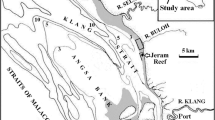Abstract
The natural diet and prey abundance of the benthic coral reef hydrozoan Nemalecium lighti, a common tropical species, were studied by analysing the gastrovascular contents of polyps. Prey capture was estimated from 10 samples collected at 3-h intervals during a single diel cycle (1–2 September, 1995) in the San Blas Islands (Panamá). Prey size ranged from 5 to 550 μm, with invertebrate larvae being the main contributor to the diet of the species. Prey items were found in 56–88% of the polyps over the entire diel cycle. Gastrovascular contents varied between 0.93 and 2.13 prey items per polyp. These capture incidences are among the highest reported for cnidarian species. Such rates would allow for high production rates for Nemalecium lighti, consistent with reports of the species’ fast growth and high reproduction rates. The observations suggest that some hydrozoans may be active heterotrophic components in coral reef ecosystems.
Similar content being viewed by others
Author information
Authors and Affiliations
Additional information
Accepted: 3 January 1999
Rights and permissions
About this article
Cite this article
Coma, R., Ribes, M., Orejas, C. et al. Prey capture by a benthic coral reef hydrozoan. Coral Reefs 18, 141–145 (1999). https://doi.org/10.1007/s003380050168
Issue Date:
DOI: https://doi.org/10.1007/s003380050168




